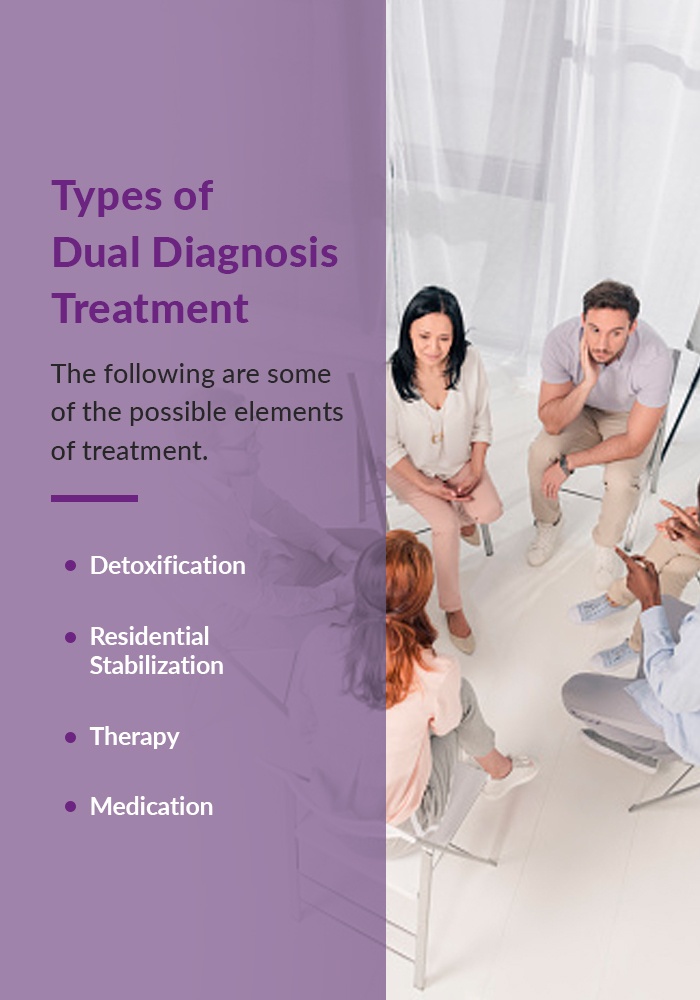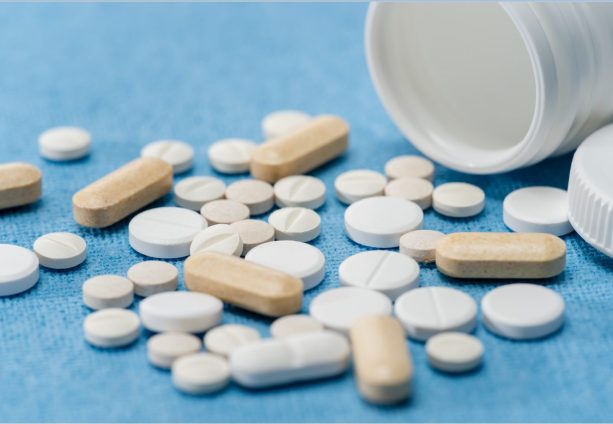Addiction to any substance is a serious mental health condition. Many people don’t realize that substance abuse and addiction can occur at the same time as another mental illness. When someone can be diagnosed with multiple mental health disorders, it’s referred to as a dual diagnosis. When designing a treatment plan for someone with an addiction as well as a co-occurring mental health condition, it’s essential to treat both disorders at the same time to create the best chances for success.
For some people, the use of illicit substances is a form of self-medication driven by an underlying psychiatric disorder. In the past, addictions and mental illnesses were considered two separate issues that couldn’t be treated concurrently. This unfortunate misconception has led many people not receiving the treatment they need to overcome addiction. When only about 11% of the people who need substance abuse treatment receive it, the development of a new type of treatment is a significant advancement.
Treatment for dual diagnosis is an integrated approach that seeks to explore and address a person’s co-occurring substance use disorder as well as any underlying mental health issues they may have. In the past, “sequential treatment” was the main method of addressing addiction. In the sequential model, clinicians drew a line between addiction treatment and other mental health treatment. If someone had depression along with an alcohol use disorder, the substance abuse would be treated before the depression.
The sequential model essentially ignored other mental health conditions to try to treat addiction first, and this approach often ignored the many ways mental illness influences addiction. Even now, many addiction treatment programs don’t treat people with a dual diagnosis because it requires a more individualized plan.
Dual diagnosis treatment’s more holistic approach addresses critical factors that could reduce a person’s chance for a successful recovery.
Dual diagnosis is surprisingly common. According to the most recent National Survey on Drug Use and Health (NSDUH), 9.2 million adults in the U.S. struggled with both a mental illness and a substance use disorder. These five mental illnesses are some of the most common to co-occur with addiction.
Major depressive disorder is one of the most common mental illnesses. Just over 17 million adults have had one or more major depressive episodes, which represents 7.1% of all adults in the United States. Depression is more common in women, and people ages 18 to 25.
Depression is a frequent contributor to addiction in part due to the fluctuations of emotional pain and apathy it makes people feel. When someone stops feeling pleasure in life, the feeling of emptiness may drive them to abuse a substance in an attempt to feel better. The symptoms of depression include:
In combination with substance abuse, depression can seriously interfere with a person’s ability to fulfill basic responsibilities or pursue their normal activities.
Anxiety disorders affect 50 million Americans — more than 18% of the adult population. It is the most common mental illness in the U.S., yet less than 37% of people who have it get treatment. To complicate matters, anxiety and depression tend to go hand in hand. It is estimated that almost half of people diagnosed with depression can also be diagnosed with anxiety. Some of the more common symptoms of anxiety and anxiety attacks include:
The symptom most predictive of substance abuse is avoidant behavior. People with this disorder will often avoid situations that trigger their anxiety, and substance abuse is a common method of self-medication. For instance, someone with social anxiety may opt to get drunk at the party rather than stay home altogether, and eventually find they like how alcohol makes them feel in other situations. The interplay between anxiety and addiction is significant and takes work to unravel.
PTSD happens when someone has gone through trauma. Trauma can be defined as a shocking, dangerous and potentially life-threatening event that a person witnesses or experiences. Unfortunately, trauma is quite common. About 60% of men and 50% of women experience trauma at some point, but not all develop PTSD. About 7 to 8% of people experience PTSD at one time or another in their lives.
PTSD is closely correlated with substance abuse. About half of people seeking treatment for a substance use disorder meet criteria necessary to be diagnosed with PTSD. Abusing alcohol or drugs like prescription opioids can mask symptoms of PTSD such as anxiety and intrusive thoughts, but does nothing to address the underlying trauma. Dual diagnosis treatment is necessary for this unique situation.
Although many people think of ADHD as a childhood disorder, it affects about 4.4% of adults ages 18 to 44. One of the central symptoms that can lead to substance abuse and addiction is impulsiveness and difficulty controlling urges. Fortunately, ADHD can be managed with the use of prescription stimulants like Adderall®, which have not been shown to worsen substance use.
In addition to problems with impulse control, ADHD often includes anxiety and sometimes depression. ADHD can co-occur with multiple disorders, making it essential to get treatment that can address many overlapping symptoms in addition to addiction.
Bipolar disorder is relatively rare, only affecting about 2.8% of adults in the United States. While research has not uncovered a single cause of the disorder, it is believed that genetics, stress or trauma and brain structure may play a role in its development. People living with bipolar disorder struggle with alternating between manic and depressive episodes. During a manic episode, someone will:
During a depressive episode, the person will feel all the classic symptoms of major depressive disorder. Sometimes, people experience a mixture of symptoms at the same time. In the 1990s, researchers discovered that individuals with bipolar disorder show extremely high rates of substance abuse, and that substance abuse worsens the symptoms of the disorder. Dual diagnosis treatment is the most appropriate way to address both disorders and improve their symptoms at once.




One of the critical steps in treating a dual diagnosis is removing the substance of abuse from the individual’s system. Depending on the substance and the severity of the addiction, it can be quite dangerous to attempt detoxification alone. Medically supervised detox minimizes the worst physical symptoms of drug withdrawal and provides support to the individual throughout the process. It’s often the first step in treating a dual diagnosis.
Because co-occurring disorders are more complex, those struggling with a dual diagnosis may benefit from the extra structure and accountability involved in residential stabilization. This type of program helps people stay sober during post-acute withdrawal syndrome (PAWS). PAWS can produce symptoms like:
In some cases, PAWS can even result in seizures. Reaching a stabilized state with a residential program helps ensure that participants have access to proper medical care and don’t lose steam in the first weeks of recovery.
Therapy is absolutely essential to dual diagnosis treatment. Addiction therapy comes in multiple forms, with cognitive behavioral therapy (CBT) producing good results for dual diagnosis. CBT operates on three central principles:
CBT helps people recognize when their thinking is distorted, and reevaluate their thoughts through a more realistic lens. Participants learn how to use problem-solving skills to defuse uncomfortable or difficult situations, and how to stop unwanted behaviors such as drug use.
Therapy is necessary to find and address the root cause of addiction. Working with a dual diagnosis makes it even more crucial to understand how one or more mental illnesses influence addiction to find the most effective means of recovery. Other types of therapy include:
People working toward recovery may benefit from participation in multiple therapy types.



With a co-occurring disorder, getting the right medication can be instrumental in treating addiction. If someone’s addiction is co-occurring with depression, for example, the individual will likely benefit from taking an anti-depressant like a selective serotonin reuptake inhibitor (SSRI) during and after treatment. Likewise, someone with newly-diagnosed ADHD may see better success in addiction treatment when the symptoms of their mental health disorder are addressed with prescription medication.
Medication is also a central part of the detoxification process. Most substances of abuse cause the brain to produce painful withdrawal symptoms when someone stops consuming them. A good detoxification program can tailor a medication plan to every individual’s needs.
People with a dual diagnosis must manage their mental illness as well as their recovery from addiction over the long term, and it can be extremely challenging. With effort and a drive to change, as well as the following tips, people can lead happy and healthy lives with a dual diagnosis.
Dual diagnosis treatment is all about implementing change. To do that, people in recovery have to break the old habits that worsened their mental illness and led to addiction. However, replacing those bad habits with healthy ones is just as important.
One of the most effective habits to form is exercise. Multiple forms of aerobic exercise like jogging or swimming have long been proven to reduce anxiety and depression, which many people struggle with in recovery. Even some light gardening can fulfill your need for exercise. Healthy eating is another excellent habit to develop. In addition to supporting the health of your brain, many people find learning to cook is therapeutic.
The importance of strong social support in recovery cannot be underestimated. No one can pursue recovery alone, and finding a support group often reduces the chances of relapse. A person’s support network can include friends and family, but many in recovery find that an addiction-specific group provides empathy others can’t. Groups like Alcoholics Anonymous and SMART Recovery are dedicated to helping people succeed in recovery through mutual understanding and support.
The Substance Abuse and Mental Health Services Administration (SAMHSA) helps people in recovery find addiction support groups nearby. It’s important to remember that not every support group format is effective for every person. Many people find they have to try a couple of different groups before finding a good fit.
Substance abuse takes up a lot of time and energy, often at the expense of other activities in a person’s life. A hallmark of addiction, as well as some mental illnesses like depression, is a lack of interest in activities, but finding something to do to fill some idle time can greatly aid in recovery.
Some people find that solitary activities like making art or gardening work well for them. Others find better success with group activities like taking a class. Volunteering is an excellent way to develop motivation and help cement a person’s inclusion in their community. No matter what someone chooses to do, participating in purposeful activities is a key element in successful recovery.
Struggling with a mental illness and an addiction can feel overwhelming, but there is hope in dual diagnosis treatment. Our goal at Diamond House Detox is to treat each client as an individual. That’s why when you come to us, we assess you to determine the best course of action. After all, undiagnosed mental health issues contribute to addiction when left unaddressed.
When you come to Diamond House Detox, you may be given an in-depth comprehensive psychiatric evaluation to determine if you have a co-occurring disorder. Our team includes qualified mental health professionals specializing in addiction who can decide if you require dual diagnosis treatment.
Diamond House Detox is one of the premier dual diagnosis treatment centers for co-occurring disorder treatment in Northern California. If you’re looking for dual diagnosis addiction treatment near Sacramento, we invite you to call us any time for confidential help at (800)205-6107 or contact us online. We’ll answer all your questions about drug rehab for dual diagnosis in California and explain the next steps in your journey to recovery.
Contact Us